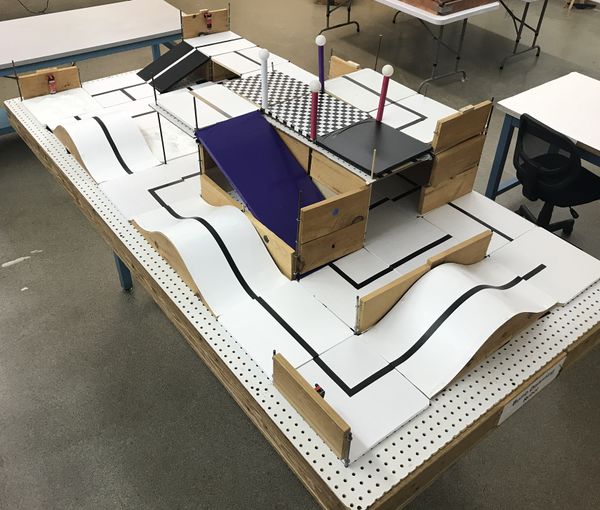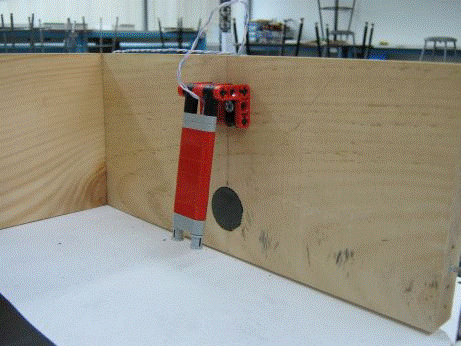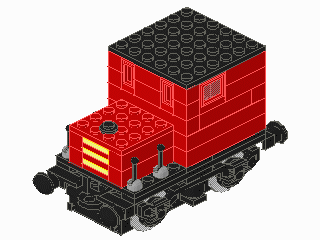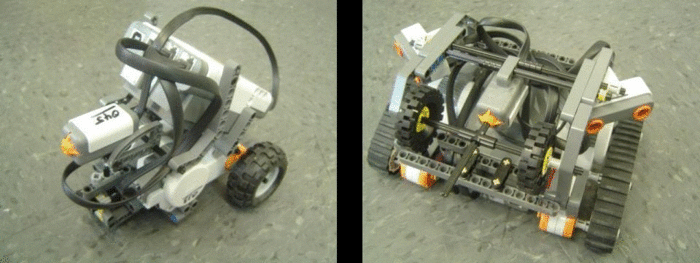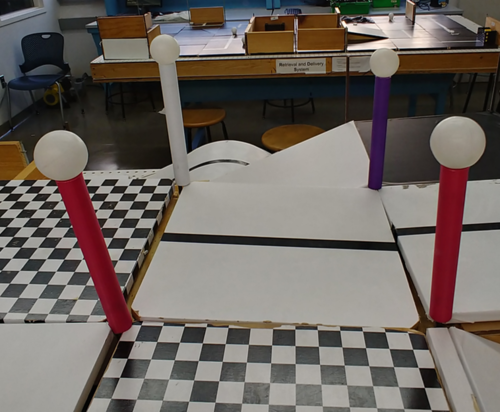Difference between revisions of "Bomb Disarming Robot (BDR)"
(1003 --> 1004) |
|||
| (102 intermediate revisions by 7 users not shown) | |||
| Line 1: | Line 1: | ||
{{SLDP: RFP|Bomb Disarming Robot (BDR)}} | |||
{{SLDP: Real-life Scenarios (Robots)}} | |||
{{SLDP: Outside Materials (Robots)}} | |||
= Introduction and Overview = | |||
was established in 2002 by an executive order issued by President George W. Bush. | The United States Department of Homeland Security was established in 2002 by an executive order issued by President George W. Bush. The department is an amalgamation of 22 federal agencies all dedicated in various ways to the protection of the United States. The Department has three primary missions: | ||
The department is an amalgamation of 22 federal agencies all dedicated in | # To prevent terrorist attacks within the United States, | ||
various ways to the protection of | # To reduce America's vulnerability to terrorism, and | ||
missions: | # To minimize the damage from potential attacks and natural disasters. | ||
Among its many directives, the department considers it a top priority to reduce the threat imposed by explosive devices to both citizens and first responders. As recent events have made clear, the potential danger to innocents is real and is one to contend with. A strategic component of the department's 10-point plan to deal with explosives that threaten the citizenry is a fully autonomous robot designed to navigate to an explosive device and disarm it. Such a machine would not only reduce the threat to bystanders but would protect the brave men and women who have dedicated their lives to the safety of the country. | |||
< | This bomb disarming robot, codenamed <b>BDR</b>, should be nimble and effective. Your design must be reliable and cost-effective, as the department envisions the deployment of a large number of BDRs throughout the country. The winning proposal must demonstrate the dependability of your design. Innovation in your approach to the problem will be rewarded. | ||
= Specifications = | |||
Design a robot using LEGO Digital Designer as your primary design tool. Your team must build a model of your design using the materials provided. A LEGO EV3 Mindstorms program that will direct the robot's movements must be created. A cost estimate of the robot's components must be provided. All revisions to the original design must be recorded and explained. This includes technical design drawings as well as cost estimates. All revisions to the Mindstorms program must be recorded and explained. | |||
The BDR must be able to move autonomously over a pre-selected route, disarm a bomb, avoid any decoy bombs, and, for extra credit, disable and retrieve triangulation devices, returning them to the start point. The BDR must not touch the decoy bombs even after they disarm the bomb. The robot must fit in a start area that is 12 in × 12 in × 12 in high (see Figure 1). These specifications <b>must</b> be met for final Commissioning. | |||
The robot's Mindstorms program may not be altered or switched during any part of the mission. Likewise, the robot must be fully autonomous, and therefore cannot be touched by any person during testing. Please refer to the course syllabus for all due dates. | |||
== Course Layout == | |||
< | You have two choices for the route your robot can take to disarm the bomb: | ||
*<b>Route 1:</b> The robot must follow the black line, traverse the black tunnel, disarm the bomb, and return to the start area. | |||
*<b>Route 2:</b> The robot must navigate the perimeter of the course, proceed to the bomb's location, disarm it, and return to the start area. | |||
to the start | |||
[[Image:BDR_Course1-1-.jpg|thumb|600px|frame|center|Figure 1: BDR course layout view 1.]] | |||
[[Image:BDR_Course2-1-.jpg|thumb|600px|frame|center|Figure 2: BDR course layout view 2.]] | |||
[[Image:modular4.gif|frame|center|Figure 3: Your robot must avoid these decoy bombs.]] | |||
'''Please Note''': Projectile designs (catapult, slingshot, etc.) are not allowed; your robot must travel to the bomb in order to disarm it. | |||
If you would like to design your own route, you may ask your instructor for permission. Creativity and innovation are always rewarded. Original designs will receive extra credit. | |||
{{SLDP: Microsoft Project}} | |||
{{SLDP: Drawings (Robots)|4}} | |||
[[Image:Modular6.gif|frame|center|Figure 4: Sample isometric drawing from LEGO Digital Designer.]] | |||
== Model == | |||
You must build a scale model (1:1) of your design. The following materials will be provided: | |||
# Mindstorms kit | |||
# One EV3 brick | |||
# Sensors | |||
# Motors | |||
The finished BDR must fit within the boundaries of a 12 in × 12 in × 12 in cube. Any additional components that your robot is equipped with must also fit within the boundaries of the same cube. Additional materials can be supplied by your TA. | |||
[[Image:modular7.gif|thumb|center|700px|Figure 5: Examples of past robots constructed from the provided materials.]] | |||
{{SLDP: Cost Estimate (Robots)}} | |||
== Extra Credit == | |||
For extra credit, your BDR can disable the triangulation system by disabling at least two devices (knocking the ping pong balls off of their tubes). The devices are located on the roof of the complex. One of these triangulation devices may be retrieved and returned to the start area for additional extra credit. The placement of the devices is shown below in Figure 6: | |||
[[Image:BDRtria.png|thumb|500px|frame|center|Figure 6: Triangulation devices.]] | |||
You can also receive extra credit for completing Benchmark A, Benchmark B, or Submission early, or completing your respective SLDP's 3D printing extra credit task as described in the [https://manual.eg.poly.edu/index.php/Prototyping_Guide Prototyping Guide]. Refer to the [https://manual.eg.poly.edu/index.php/EG_Grading_Policy EG1004 Grading Policy] for exact point values. Creativity and innovation are always rewarded. Original designs will receive extra credit. | |||
{{SLDP: Milestones and Benchmarks}} | |||
{{SLDP: Milestone 1 (Robots)}} | |||
{{SLDP: Benchmark A}} | |||
* Robot traverses two hills or the black tunnel | |||
* Submission of mandatory 3D print: This includes the submission of either a logo design or extra credit print in the 3D Printing Submission portal on the EG1004 website | |||
**More details about this can be found in the [https://manual.eg.poly.edu/index.php/Prototyping_Guide Prototyping Guide] | |||
* Submission of updated notebook/project journal on the EG1004 website | |||
{{SLDP: Milestone 2 (Robots)}} | |||
{{SLDP: Benchmark B}} | |||
* Robot disarms bomb (presses doorbell) | |||
* Approval of mandatory 3D print: This includes receiving approval of either a logo design or extra credit print by a Protolab TA in the EG1004 Protolab, and showing your Proof of Approval form to a TA | |||
* Submission of updated notebook/project journal on the EG1004 website | |||
{{SLDP: Milestone 3 (Robots)}} | |||
{{SLDP: Commissioning}} | |||
* Robot returns to base after disarming the bomb | |||
* Printed mandatory 3D print | |||
{{SLDP: Final Presentation}} | |||
* Problem statement | |||
* Solution overview | |||
* Company description and qualifications | |||
* Drawings | |||
* Mindstorms program | |||
* Cost estimate | |||
* Microsoft Project schedule | |||
* Video demonstration | |||
* Why should the company be awarded this contract? | |||
{{SLDP: Submission}} | |||
** Final presentation | |||
** Final Mindstorms program | |||
** Initial sketch | |||
** All the drawings of your design (initial through final) | |||
** Video | |||
** Final Microsoft Project Schedule | |||
** Final cost estimate | |||
** Resume(s) (no fictitious resumes will be accepted) | |||
** Final notebook/project journal | |||
{{SLDP: Early Acceptance}} | |||
{{SLDP: Late Delivery}} | |||
= Frequently Asked Questions = | |||
Q: Can our robot climb up walls? | |||
A: Yes, robots are allowed to climb up walls on this course. | |||
Q: If we go to the bomb using the perimeter of the course route and then return to the start tile using the tunnel route (or vice versa), will we receive extra credit for completing both routes? | |||
A: Yes. | |||
Q: Can we build some arm extension for our robot to disarm the bomb so that it does not have to reach the actual bomb tile? | |||
A: No, arms are not allowed. On this course, your robot must actually get itself to the bomb tile and press the disarm button to receive credit. | |||
get | |||
to | |||
{{Semester-Long Design Project}} | |||
Latest revision as of 02:39, 31 August 2022
Request for Proposal: Bomb Disarming Robot (BDR)
This project reflects real life scenarios; the robot must be able to handle minor imperfections in the course.
Note: You should only use the materials contained in the price list for LEGO parts for robot projects. If you want to use other parts, get permission from your faculty member to do so, and also to determine the cost of the parts you want to use that are not in this price list.
Introduction and Overview
The United States Department of Homeland Security was established in 2002 by an executive order issued by President George W. Bush. The department is an amalgamation of 22 federal agencies all dedicated in various ways to the protection of the United States. The Department has three primary missions:
- To prevent terrorist attacks within the United States,
- To reduce America's vulnerability to terrorism, and
- To minimize the damage from potential attacks and natural disasters.
Among its many directives, the department considers it a top priority to reduce the threat imposed by explosive devices to both citizens and first responders. As recent events have made clear, the potential danger to innocents is real and is one to contend with. A strategic component of the department's 10-point plan to deal with explosives that threaten the citizenry is a fully autonomous robot designed to navigate to an explosive device and disarm it. Such a machine would not only reduce the threat to bystanders but would protect the brave men and women who have dedicated their lives to the safety of the country.
This bomb disarming robot, codenamed BDR, should be nimble and effective. Your design must be reliable and cost-effective, as the department envisions the deployment of a large number of BDRs throughout the country. The winning proposal must demonstrate the dependability of your design. Innovation in your approach to the problem will be rewarded.
Specifications
Design a robot using LEGO Digital Designer as your primary design tool. Your team must build a model of your design using the materials provided. A LEGO EV3 Mindstorms program that will direct the robot's movements must be created. A cost estimate of the robot's components must be provided. All revisions to the original design must be recorded and explained. This includes technical design drawings as well as cost estimates. All revisions to the Mindstorms program must be recorded and explained.
The BDR must be able to move autonomously over a pre-selected route, disarm a bomb, avoid any decoy bombs, and, for extra credit, disable and retrieve triangulation devices, returning them to the start point. The BDR must not touch the decoy bombs even after they disarm the bomb. The robot must fit in a start area that is 12 in × 12 in × 12 in high (see Figure 1). These specifications must be met for final Commissioning.
The robot's Mindstorms program may not be altered or switched during any part of the mission. Likewise, the robot must be fully autonomous, and therefore cannot be touched by any person during testing. Please refer to the course syllabus for all due dates.
Course Layout
You have two choices for the route your robot can take to disarm the bomb:
- Route 1: The robot must follow the black line, traverse the black tunnel, disarm the bomb, and return to the start area.
- Route 2: The robot must navigate the perimeter of the course, proceed to the bomb's location, disarm it, and return to the start area.
Please Note: Projectile designs (catapult, slingshot, etc.) are not allowed; your robot must travel to the bomb in order to disarm it.
If you would like to design your own route, you may ask your instructor for permission. Creativity and innovation are always rewarded. Original designs will receive extra credit.
Project Schedule
A project schedule must be created in Google Sheets. Please refer to the template provided in your team Google Drive folder and our guide.
This schedule must include all tasks related to the project from the start of the project to Early or Final submission. The project schedule should include:
- Minimum of 20 tasks, excluding Milestones
- Milestones should be clearly indicated on the project plan (duration of zero days)
- Each task must include the person responsible for completing the task (resource names)
- Gantt chart must be displayed alongside the tasks list (fit onto one slide)
- Gantt chart must show a progress line
- Clearly state during the presentations whether the project is on-time, behind schedule, or ahead of schedule
- In milestone presentations, please present a “Project Status” slide, which should summarize key deadlines. You are not required to show your project schedule in these presentations
Drawings
All drawings and sketches should be made using LEGO Digital Designer (LDD). LDD can be installed for free from the LEGO website.
Using LDD, create four drawings of the robot: front, top, most detailed side, and a drawing of the gear train(s). Sensors, motors, and gears must be included in each drawing. If the robot does not use any gears, make sure to explicitly state that in your presentations.
Each revision of the design must be documented and all changes must be presented during Milestone presentations.
Model
You must build a scale model (1:1) of your design. The following materials will be provided:
- Mindstorms kit
- One EV3 brick
- Sensors
- Motors
The finished BDR must fit within the boundaries of a 12 in × 12 in × 12 in cube. Any additional components that your robot is equipped with must also fit within the boundaries of the same cube. Additional materials can be supplied by your TA.
Cost Estimate
Once a robot design is complete, a cost estimate must be generated that specifies the cost of all the materials and labor required for the construction of the design. Tabulate this cost information clearly in an Excel spreadsheet, using the materials cost list provided. Help in calculating the cost is available by reviewing how to plan the schedule and calculate costs for a project. The costs for the parts can be found on the price list for LEGO parts for robot projects.
Note: You should only use the materials contained in the price list for LEGO parts for robot projects. If you want to use other parts, get permission from your faculty member to do so, and also to determine the cost of the parts you want to use that are not in this price list.
The cost estimate should include the following:
- Labor cost breakdown with hours and rates
- Consolidate low-cost pieces: axles, beams, bricks, bushings, connectors, gears, plates
- Itemize high-cost pieces: controllers (EV3 brick), sensors, motors
- No decimal places; this is an estimate after all. Round appropriately
- Total cost must be shown in the bottom right corner
Notebook/Project Journal
While working on your project, you are expected to keep a record of all work done, as well as future plans and goals. In order to complete a Benchmark assessment, you must submit your notebook in .pdf format to the EG1004 website, as well as show your notebook to the Open Lab TA completing your assessment. A guide to writing the notebook, as well as a basic overview of its expectations, can be found here.
Extra Credit
For extra credit, your BDR can disable the triangulation system by disabling at least two devices (knocking the ping pong balls off of their tubes). The devices are located on the roof of the complex. One of these triangulation devices may be retrieved and returned to the start area for additional extra credit. The placement of the devices is shown below in Figure 6:
You can also receive extra credit for completing Benchmark A, Benchmark B, or Submission early, or completing your respective SLDP's 3D printing extra credit task as described in the Prototyping Guide. Refer to the EG1004 Grading Policy for exact point values. Creativity and innovation are always rewarded. Original designs will receive extra credit.
Milestones, Benchmarks, and Deliverables
As work is done on the project, three Milestone presentations will report on the project's progress. All of the items assigned in each phase of the project are called Benchmark deliverables. These deliverables often consist of a combination of written submissions, presentations, and demonstrations. Benchmark assessments evaluate the progress of the project.
Preliminary Design Investigation
The Preliminary Design Investigation (PDI) is extremely important, as it lays the groundwork for the project. It outlines the project idea, inspiration, and goals.
The PDI must include:
- Cover Page
- Project Overview
- Goals & Objectives
- Design & Approach
- Cost Estimate
- Project Schedule
- Relevant Pictures
An example PDI template can be found here. The PDI is due by Benchmark A. Do not forget to include the items listed above. Use this link to access the VEX PDI Rubric.
Milestone 1
See How To Give a Milestone Presentation for the format of a Milestone presentation.
Milestone 1 is a presentation of the PDI. It is important that it outlines the project goals and show that the project is realizable.
The Milestone 1 presentation must include:
- Company profile
- Company name
- Product name
- Company officer title(s)
- Mission statement
- Project objective
- What is the project about?
- What tasks is the company aiming to accomplish? (Benchmark A requirements)
- Overall design approach to complete objective
- Background information
- Why is the project happening?
- What does the audience need to know?
- Technical design description
- Preliminary conceptual drawing of robot design
- Rendered and digital sketches are acceptable, CAD not required
- What components will be used and why?
- Preliminary conceptual drawing of robot design
- Cost estimate
- Major components of design listed
- Miscellaneous category listed
- Projected labor listed
- Microsoft Project schedule
- Click here to access the guide on how to transfer a file
- Teamwork agreement summary
- Summary
- Overall assessment on current state of project
- Is the project on schedule? Is it on budget?
- Next steps and future tasks
Look Ahead: What tasks are planned between now and Milestone 2?
Benchmark Assessment A
Benchmarks evaluate the progress of the project. Benchmark A is due at the end of Model Shop Session II. There are penalties for not completing this on time. Refer to the EG1004 Grading Policy for more information.
To pass Benchmark A, the design must complete all of the following:
- Robot traverses two hills or the black tunnel
- Submission of mandatory 3D print: This includes the submission of either a logo design or extra credit print in the 3D Printing Submission portal on the EG1004 website
- More details about this can be found in the Prototyping Guide
- Submission of updated notebook/project journal on the EG1004 website
Milestone 2
See How To Give a Milestone Presentation for the format of a Milestone presentation.
Milestone 2 Deliverables:
- Presentation:
- Project description
- Design approach
- Design changes since Milestone 1
- Mission statement
- CAD drawings: top, front, most detailed side, isometric, gear train
- Mindstorms program
- Updated cost estimate (previous and current). What changes were made?
- Updated Microsoft Project schedule (previous and current). What changes were made?
- Progress update: current state of the project (time, budget, etc.)
Look Ahead: What tasks are planned between now and Milestone 3?
Benchmark Assessment B
Benchmark Assessment B is due at the end of Model Shop Session III. There are penalties for not completing this on time. Refer to the EG1004 Grading Policy for more information.
To pass, complete all of the following tasks:
- Robot disarms bomb (presses doorbell)
- Approval of mandatory 3D print: This includes receiving approval of either a logo design or extra credit print by a Protolab TA in the EG1004 Protolab, and showing your Proof of Approval form to a TA
- Submission of updated notebook/project journal on the EG1004 website
Milestone 3
See How To Give a Milestone Presentation for the format of a Milestone presentation.
Milestone 3 Deliverables:
- Presentation:
- Project description
- Design approach
- Design changes since Milestone 2
- Mission statement
- CAD drawings: top, front, most detailed side, isometric, gear train
- Mindstorms program
- Updated cost estimate (previous and current). What changes were made?
- Updated Microsoft Project schedule (previous and current). What changes were made?
- Progress update: current state of the project (time, budget, etc.)
Look ahead: What tasks are planned between now and the completion of the project?
Commissioning
Projects must be commissioned before Submission. Refer to the syllabus for Submission deadlines. There are penalties for not completing this on time. Refer to the EG1004 Grading Policy for more information.
To pass, the design must complete all of the following:
- Robot returns to base after disarming the bomb
- Printed mandatory 3D print
Final Presentation
The Final Presentation will be a technical briefing, similar to the Milestones, but also serves as a sales presentation explaining why your company should be selected instead of the competition.
Your Final Presentation must include:
- Company profile
- Company name
- Employee profile, role(s), and qualifications
- Mission statement
- Problem statement
- Why is the project happening?
- What does the audience need to know?
- Project objective
- What is the purpose of your project?
- Who does your project help?
- What problem does your project solve?
- Project description
- Specify LEED certification
- Examples of LEED implementations in Revit
- Revit drawings
- All floor plan drawings
- Dimensions
- 1:240 scale
- Views of exterior of building: front elevation, side elevation, isometric elevation
- Dimensions
- Specify LEED certification
- Market and product viability
- Does your company have competitors?
- What makes your project unique?
- How does your design compare to competitors - cost, quality, features?
- Is the project versatile?
- What is the price of your project?
- Conclusion
- Reiterating project purpose
- Highlight project features
- Future goals of the company
- Why should your company be awarded this contract?
- Video pitch
- Price of project
- Walkthrough animation of building in Revit
- Embedded into Final Presentation
- Problem statement
- Solution overview
- Company description and qualifications
- Drawings
- Mindstorms program
- Cost estimate
- Microsoft Project schedule
- Video demonstration
- Why should the company be awarded this contract?
Submission
All SLDPs must be submitted online. Please visit this page for the link to the Project Submission form and each project’s individualized login information. To submit, login to the EG1004 website using this special login information. Submitting with an NYU account or any other account will generate an error. Components may be resubmitted at any time before the deadline. Please note that submission times are based on the most recent submission.
Please note the deliverables for this project are as follows. If any of the following items are omitted, there will be a penalty. Be sure to click "Submit" at the bottom of the form and allow sufficient time for uploading. The following list includes deliverable items that are required:
- Submission deliverables:
- Final presentation
- Final Mindstorms program
- Initial sketch
- All the drawings of your design (initial through final)
- Video
- Final Microsoft Project Schedule
- Final cost estimate
- Resume(s) (no fictitious resumes will be accepted)
- Final notebook/project journal
Late Submission
Late submission is not allowed. If a project does not Commission or receive Partial Commission by the deadline set forth in the syllabus, the project will not be allowed to submit and will receive a 0 for the project grade. To receive Partial Commissioning, two TAs must evaluate the project and determine its degree of completion according to the Commissioning requirements and the project will be given a grade accordingly. Please refer to the EG1004 Grading Policy for more information.
Frequently Asked Questions
Q: Can our robot climb up walls?
A: Yes, robots are allowed to climb up walls on this course.
Q: If we go to the bomb using the perimeter of the course route and then return to the start tile using the tunnel route (or vice versa), will we receive extra credit for completing both routes?
A: Yes.
Q: Can we build some arm extension for our robot to disarm the bomb so that it does not have to reach the actual bomb tile?
A: No, arms are not allowed. On this course, your robot must actually get itself to the bomb tile and press the disarm button to receive credit.
| ||||||||

